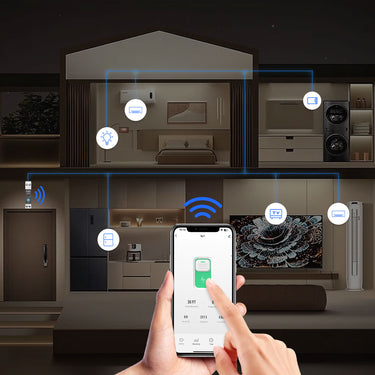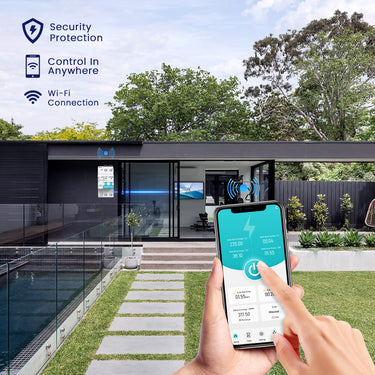Sizing Guide: From 1–20A to 1–63A — Avoid Nuisance Trips While Staying Code-Safe
TL;DR — Quick rules you can apply today
- Calculate load current: Iload=V×PFP (single-phase).
- Continuous loads: choose a device ≥ 125% of design current (or per your local code).
- Motors/transformers/LED drivers: expect inrush; start with Curve C (or D for very high inrush).
- Choose leakage type: for smart RCBOs, default to Type A unless loads are strictly linear.
- Breaking capacity: device Icn/Icu ≥ prospective short-circuit current at the board (e.g., 6 kA).
- Metal enclosures: plan for Wi-Fi/Zigbee signal (antenna or hub placement).
- Document: record settings (over-current limit, leakage setpoint, auto-reclose policy).
Step-by-step sizing (copy/paste checklist)
Step 1 — Determine the load and duty
-
Resistive (heaters, incandescent): steady current, low inrush
-
Mixed/electronic (LED drivers, IT gear): moderate inrush
-
Inductive (motors, pumps, compressors): high inrush
Step 2 — Calculate design current
-
Single-phase: I=V×PFP
-
Three-phase (line current): I=3V×PFP
Step 3 — Apply the “continuous load” factor
-
For loads running ≥ 3 hours, many codes require sizing at 125% of continuous load current.
-
Round up to a standard rating (e.g., 10A, 16A, 20A, 25A, 32A, 40A, 50/63A).
Step 4 — Pick the trip curve
| Trip curve | Inrush tolerance | Typical use | Tip |
|---|---|---|---|
| B | Low | Resistive, small electronics | Most sensitive to inrush—good for lighting/outlets |
| C | Medium | General purpose, small motors, mixed loads | Default for many smart breakers |
| D | High | Heavy motors, transformers, welders | Use when measured/expected inrush is high |
Step 5 — Confirm breaking capacity
-
Ensure Icn/Icu (e.g., 6 kA) ≥ site short-circuit level.
-
Coordinate with upstream protection for selectivity (the downstream trips first where practical).
Step 6 — Choose RCBO type (if leakage protection is required)
-
Type A detects AC + pulsating DC → best for modern loads.
-
Type AC detects pure AC → only for strictly linear legacy loads.
Step 7 — Final checks (smart features)
-
Over-current thresholds (if the device allows fine tuning)
-
Leakage setpoint (commonly 30 mA for final circuits)
-
Auto-reclosing policy (limited retries, cool-down, lockout on repeated RCD trips)
-
Antenna/hub location for stable connectivity
Common loads: fast sizing table (230 V single-phase examples)
| Load | Power / Notes | Est. PF | Design current | Suggested device (rating & curve) |
|---|---|---|---|---|
| Space heater | 2.0 kW resistive | 0.98 | ~8.9 A | B16 smart breaker/RCBO (continuous margin) |
| Water heater | 3.0 kW resistive | 0.98 | ~13.3 A | B20 or C20 (continuous duty) |
| Air conditioner (small) | 1.5 kW compressor | 0.85 | ~7.7 A (run) | C16 (motor inrush) |
| Well pump | 1.1 kW motor | 0.80 | ~6.0 A (run) | C16 (or D16 if high inrush) |
| LED lighting circuit | 400 W mixed drivers | 0.90 | ~1.9 A | B10 (sensitive but OK) |
| IT rack (SMPS) | 1.2 kW electronics | 0.90 | ~5.8 A | C10/16 (consider C for inrush) |
1–20A vs 1–63A — when to use which range
| Range | When it fits | Typical circuits | Notes |
|---|---|---|---|
| 1–20A | Light duty & branch circuits | Lighting, IT loads, small pumps/AC | Great for fine granularity and selectivity |
| 1–63A | Heavier feeds & mixed sub-circuits | Water heaters, EV accessories*, shop circuits | Allows growth; confirm cable size and fault level |
- For EV charging equipment and similar, always follow specific local code & manufacturer instructions.
FAQs
Q1: Should I increase the amp rating to stop nuisance trips?
Not first. Match the curve (C/D for inrush) and fix wiring/grouping before increasing amperage.
Q2: Do I need Type A RCBOs for smart circuits?
Usually yes, because modern loads create pulsating DC leakage. Use Type A unless your circuit is purely linear.
Q3: Is 6 kA breaking capacity enough?
Only if your prospective short-circuit current at the board is ≤ 6 kA. Confirm with your designer/installer.
Q4: How do I size for continuous duty?
Many codes require sizing at 125% of continuous current. Check your local standard and round up to the next standard rating.
Q5: Wi-Fi keeps dropping in a metal enclosure—what to do?
Use Zigbee mesh with the hub outside the box, or a 4G variant for sites without reliable Wi-Fi.











